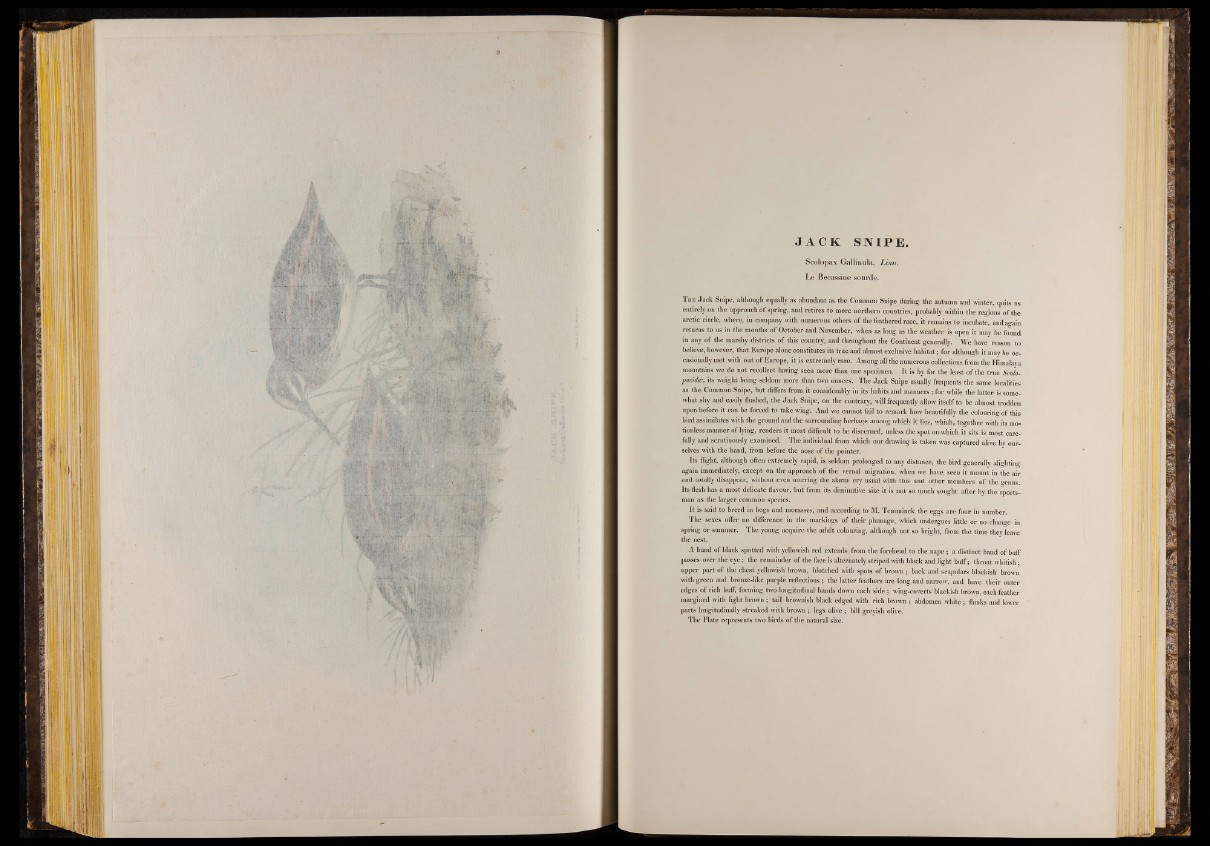
JACK SNIPE.
S c o lo p a x G a llín u la, Lin n .
L e Beca ssine sourde.
T he Jack Snipe, although equally as abundant as the Common Snipe during the autumn and winter, quits us
entirely on the approach o f spring, and retires to more northern countries, probably within the regions o f the
arctic circle, where, in company with numerous others o f the feathered race, it remains to incubate, and again
returns to us in the months o f October and November, when as long as the weather is open it may be found
in any o f the marshy districts of this country, and throughout the Continent generally. We have reason to
believe, however, that Europe alone constitutes its true and almost exclusive habitat; for although it may be occasionally
met with out o f Europe, it is extremely rare. Among all the numerous collections from the Himalaya
mountains we do not recollect having seen more than one specimen. It is by far the least o f the true Scolo-
pacida?, its weight being seldom more than two ounces. The Jack Snipe usually frequents the same localities
as the Common Snipe, but differs from it considerably in its habits and manners ; for while the latter is somewhat
shy and easily flushed, the Jack Snipe, on the contrary, will frequently allow itself to be almost trodden
upon before it can be forced to take wing. And we cannot fail to remark how beautifully the colouring o f this
bird assimilates with the ground and the surrounding herbage among which it lies, which, together with its motionless
manner o f lying, renders it most difficult to be discerned, unless the spot on which it sits is most carefully
and scrutinously examined. The individual from which our drawing is taken was captured alive by ourselves
with the hand, from before the nose o f the pointer.
Its flight, although often extremely rapid, is seldom prolonged to any distance, the bird generally alighting
again immediately, except on the approach o f the vernal migration, when we have seen it mount in the air
and totally disappear, without even uttering the alarm cry usual with this and other members o f the genus.
Its flesh has a most delicate flavour, but from its diminutive size it is not so much sought after by the sportsman
as the larger common species.
It is said to breed in bogs and morasses, and according to M. Temminck the eggs are four in number.
The sexes offer no difference in the markings of their plumage, which undergoes little or no change in
spring or summer. The young acquire the adult colouring, although not so bright, from the time they leave
the nest.
A band of black spotted with yellowish red extends from the forehead to the nape; a distinct band o f buff
passes over the e y e ; the remainder o f the face is alternately striped with black and light buff; throat whitish;
upper part o f the chest yellowish brown, blotched with spots of brown ; back and scapulars blackish brown
with green and bronze-like purple reflections ; the latter feathers are long and narrow, and have their outer
edges o f rich buff, forming two longitudinal bauds down each side ; wing-coverts blackish brown, each feather
margined with light brown; tail brownish black edged with rich brown ; abdomen white ; flanks and lower
parts longitudinally streaked with brown ; legs olive ; bill greyish olive.
The Plate represents two birds o f the natural size.